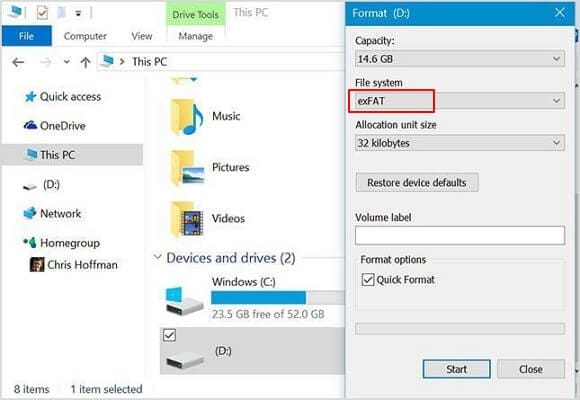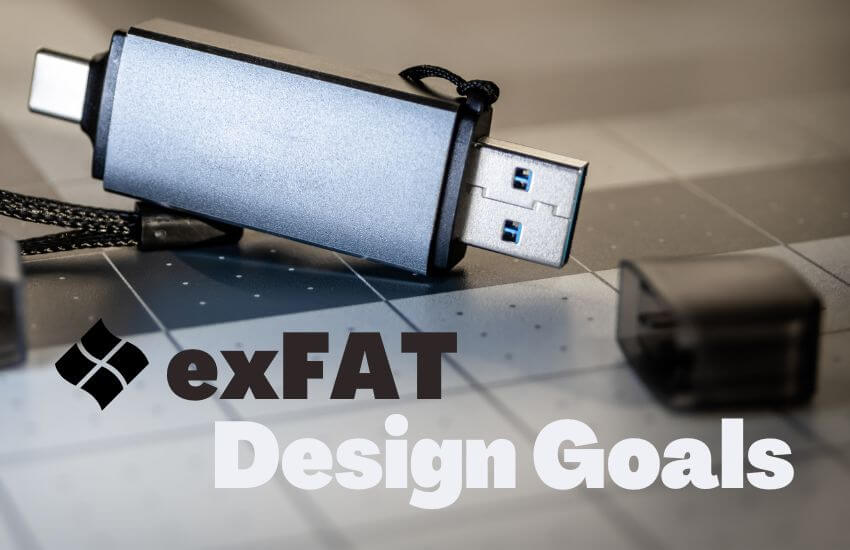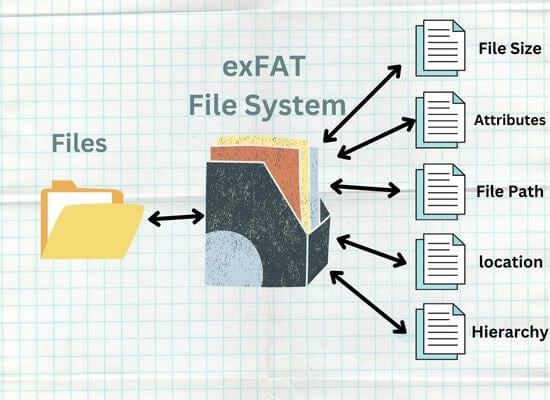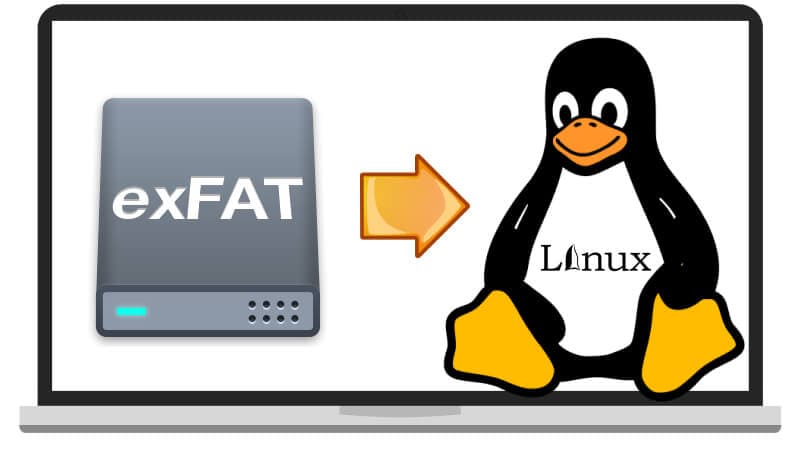
Extensible File Allocation Table or exFAT file system is a variation in former file formats. It won't be an exaggeration that the exFAT format is frequently recommended, given its advanced features.
You might have noticed three variant file options while formatting a flash drive – exFAT, FAT32, and NTFS, and it often seems trickier to opt for the right choice given the slightest technical knowledge. In this connection, you'll get detailed insights into exFAT compatibility, features & specification. This concise piece of discussion will encompass the following aspects:
In this article
Part 1. Why Microsoft Developed the exFAT File System?
Microsoft officially released the exFAT format back in 2006 as a successor of the FAT32 file system. Still, a common question may pop into many minds about why Microsoft stepped into developing the exFAT file system. In this regard, here you can find a few obvious supporting grounds. Such as:
- The first & foremost reason highlighted by Microsoft is the simplicity of almost all of the versions portrayed in the FAT file system family since exFAT is the latest addition to FAT-based file systems. Both exFAT and its older format, FAT32 is pretty easy to use. Moreover, you can go through exFAT vs. FAT32 for in-depth analysis to make the most optimum choice.
- The predecessor format FAT32 came up with a limitation over the file size as the users can't store files of sizes exceeding the 4GB limit using FAT32; likewise, you can't create partitions above the height of 8TB. Therefore, Microsoft developed exFAT as a replacement for the older format FAT32 to eradicate such limitations on file or partition size.
- The extensibility of the file system is another significant reason behind exFAT development. Since the exFAT file system is quite flexible and adaptive to innovations in storage, even given this ground, it was named as Extensible FAT format.

Part 2. Is exFAT Free or Licensed?
Are you intended to implement the exFAT format? It is of no surprise that exFAT isn't an open source; instead, you need to purchase its license from Microsoft to use it on a commercial level. Given this, often, the embedded system or device manufacturers intended to smooth out production of exFAT formatted media sign a license for exFAT. However, at the end of August 2019, Microsoft announced its specifications; since then, exFAT support has been enabled in Linux kernel 5.4 or higher.
Part 3. The Architecture of exFAT File System
The architecture of exFAT depicts how your files are stored & retrieved from your storage & media devices. Whenever you open a file on your computer system, the operating collaborates with the file system you use, i.e., exFAT; consequently, the exFAT file system retrieves & loads the respective file on the system. Likewise, exFAT can perform other related tasks; for instance, you can read, write, edit & delete your files using exFAT.

Part 4. Features of exFAT File System
Here we have cited a few salient features of exFAT with a brief explanation.
Features |
Explanation |
| Scalability | exFAT allows you to maximize the partition sizes as per your requirement without any limit. |
| File optimization | exFAT has an increased file size reference from 4 bytes to 8 bytes for storage. |
| Extended file size | Using exFAT file format, you can store large-sized files to any extent quite conveniently. |
| Allocation bitmap | exFAT uses an allocation bitmap that defines whether a particular cluster is in-use or free to allocate new data. |
| Boundary Alignment | The FAT and the clustered heap offsets are adjustable at the format point; hence, writes occur in the fewest flash blocks. |
| OEM Parameters | Block size of the underlying storage is a feature that can be included in the "OEM parameters" field. |
You may also be interested in: 4 Proved Solutions to Recover exFAT Partition
Part 5. Compatibility of exFAT File System
Is exFAT compatible with various operating systems? It is probably the most reasonable question you may look over about the exFAT format. Because suppose if you intend to format your drive with exFAT; you must ensure whether the exFAT format is compatible with your operating system before formatting. So, in this connection, all the exFAT compatible systems & devices are given below:
exFAT Compatible Operating Systems Include:
- Windows: Windows Embedded CE 6.0, Windows XP/Vista/7/8/10/11, Windows Server 2003/2008. Note that the older Windows version might require an update to be compatible with exFAT.
- Mac: Mac OS X 10.6.5 & all later versions.
- Linux: All Linux OS versions with Linux kernel 5.4 or newer.
Note: Older versions might require an exFAT FUSE driver on the system to use the exFAT format).
Other Compatible Devices Include:
- Consumer devices: Cameras, gaming consoles, and newer versions of Android phones & tablets.
- Storage & Media devices: USB flash drives, external hard drives, SSDs, SD cards, and newer versions of media players.
Part 6. Advantages & Disadvantages of exFAT File System
Despite the extravagant performance & features of the exFAT format, you may still be concerned over whether exFAT is valid or not. You must figure out why you should prioritize it over other file systems. Hence, to sort out such confusion, here we have curated lists of advantages & disadvantages of using the exFAT file system. Hopefully, you'd be able to conclude in a better way based on this quick analysis.
Pros
Efficient memory management
No limitation on file size or partition size
Helpful in data recovery
Widely compatible with operating systems
Ideal for external storage devices
Cons
Unlike NTFS file system, it lacks journaling ability
exFAT file system doesn't offer advanced features like NTFS
You can't store files of petite sizes
exFAT format provides no consistency checks
Benefits of Choosing exFAT for a Removable Media
exFAT is the most preferred format for removable media. In this context, you can consider any device, i.e., an SD card or Flash drive. Any removable media isn't confined to storing only images or less-sized files. Often, you may need to store large files, whether for the backup of a system or recording a long video that usually takes more storage space than 4GB.
In such a case, if you think the FAT32 file system can work, you're undoubtedly over-expecting as it won't allow you to accommodate any file exceeding the 4GB size limit. Therefore, exFAT is the most optimum choice you can rely upon without fear of encountering file size limitations.
Video Tutorial-FAT32 vs exFAT vs NTFS
Part 7. How To Read the exFAT Drive on Ubuntu Linux?
Although the exFAT support Linux, still some versions of Linux OS, i.e., Ubuntu Linux, don't allow you to read the exFAT drive on your system, specifically the operating systems with the older version of Linux kernel. Therefore, you may need to install the exFAT FUSE package to simplify the mounting of the exFAT drive on Linux-based systems.

Let's explore the approach you can adopt to sort the exFAT files' mount problem on the Ubuntu Linux system!
Step 1: Identify the Ubuntu Verssion.
In the first place, identify the Ubuntu version. If you're using an Ubuntu version older than 10.12, update it using the following commands in the Ubuntu Terminal.
sudo apt update
sudo apt upgrade
Step 2: Install the exFAT FUSE.
Now, you need to install the exFAT FUSE driver by running the following command in the terminal.
sudo apt install exfat-fuse exfat-utils
Step 3: Mount the exFAT Drive on Linux.
After successfully installing the exFAT FUSE module, you can instantly mount & read your exFAT drive on your Ubuntu system.
Conclusion
This comprehensive article illustrates each & everything you may want to know about the exFAT (extensible File Allocation table) file system. Doubtlessly, exFAT is also a file system like FAT32; you can perceive it as advancement from its predecessor. Because exFAT is far better than FAT32 as the exFAT file size limit isn't stuck on 4GB. Thus, if you want to format your external storage device, exFAT is so far the most recommended option, given its scalability & improved compatibility.
For Windows XP/Vista/7/8/10/11
For macOS X 10.10 or later

 ChatGPT
ChatGPT
 Perplexity
Perplexity
 Google AI Mode
Google AI Mode
 Grok
Grok























